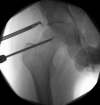Extra-articular hip impingement due to heterotopic ossification formation at the anterior inferior iliac spine following previous pelvic external fixation
- PMID: 27637275
- PMCID: PMC5030514
- DOI: 10.1136/bcr-2015-213610
Extra-articular hip impingement due to heterotopic ossification formation at the anterior inferior iliac spine following previous pelvic external fixation
Abstract
Femoroacetabular impingements (FAIs), specifically cam type and pincer type, continue to be accepted as causes of intra-articular hip pathology and sources of hip pain. Reports of other causes of hip impingement including extra-articular causes have surfaced recently. One structure of importance is the anterior inferior iliac spine (AIIS) due to its inconsistent bony morphology and the pull of the rectus femoris muscle putting it at risk for an avulsion fracture. Under certain circumstances, open surgical excision of exostosis formation after an avulsion fracture of the AIIS has been used. The case below represents a clinical scenario in which a medically unstable and multiply injured trauma patient had an external pelvic fixator placed as part of the treatment plan for an unstable pelvic injury. Following this pelvic external fixation treatment, the patient went on to develop clinically significant heterotopic bone formation at the AIIS pin site with extra-articular hip impingement syndrome.
2016 BMJ Publishing Group Ltd.
Figures




References
Publication types
MeSH terms
Substances
LinkOut - more resources
Full Text Sources
Other Literature Sources
Medical
